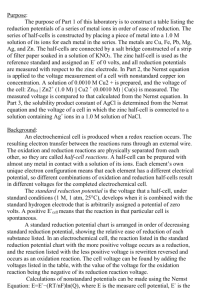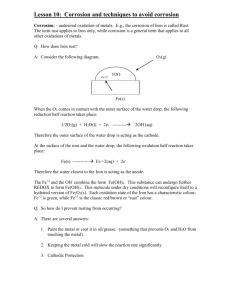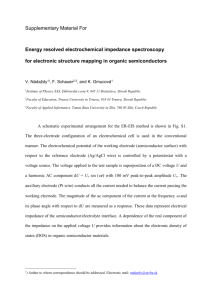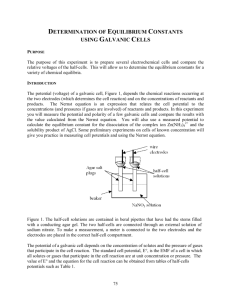Lab 15 Electrochemical Cells
advertisement
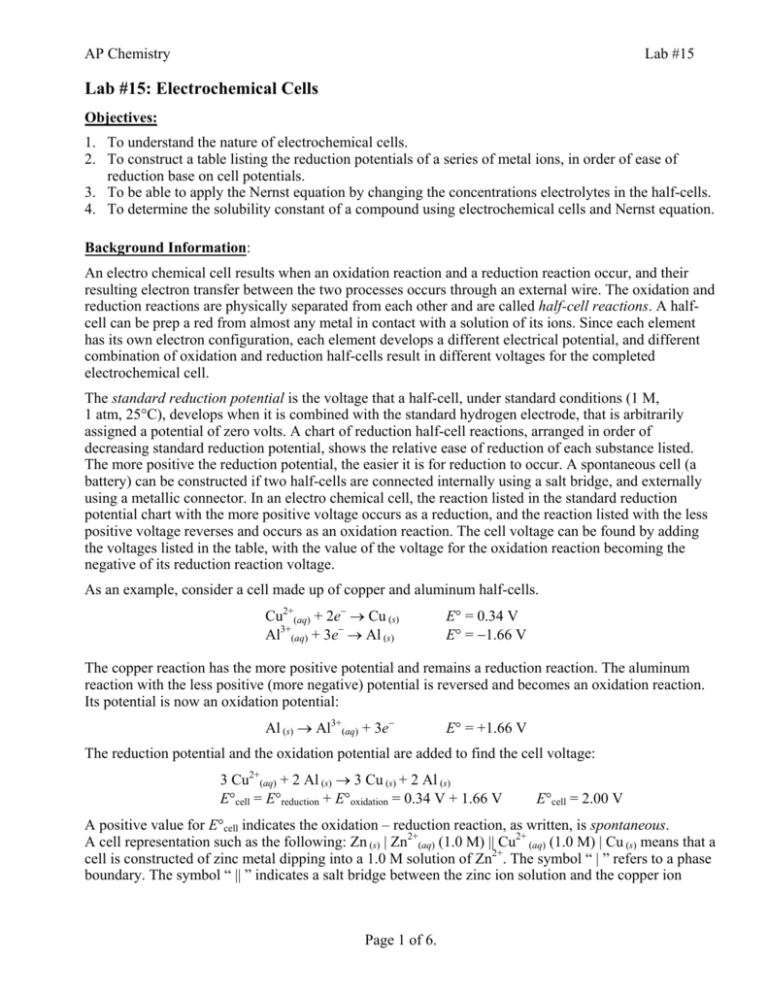
AP Chemistry Lab #15 Lab #15: Electrochemical Cells Objectives: 1. To understand the nature of electrochemical cells. 2. To construct a table listing the reduction potentials of a series of metal ions, in order of ease of reduction base on cell potentials. 3. To be able to apply the Nernst equation by changing the concentrations electrolytes in the half-cells. 4. To determine the solubility constant of a compound using electrochemical cells and Nernst equation. Background Information: An electro chemical cell results when an oxidation reaction and a reduction reaction occur, and their resulting electron transfer between the two processes occurs through an external wire. The oxidation and reduction reactions are physically separated from each other and are called half-cell reactions. A halfcell can be prep a red from almost any metal in contact with a solution of its ions. Since each element has its own electron configuration, each element develops a different electrical potential, and different combination of oxidation and reduction half-cells result in different voltages for the completed electrochemical cell. The standard reduction potential is the voltage that a half-cell, under standard conditions (1 M, 1 atm, 25°C), develops when it is combined with the standard hydrogen electrode, that is arbitrarily assigned a potential of zero volts. A chart of reduction half-cell reactions, arranged in order of decreasing standard reduction potential, shows the relative ease of reduction of each substance listed. The more positive the reduction potential, the easier it is for reduction to occur. A spontaneous cell (a battery) can be constructed if two half-cells are connected internally using a salt bridge, and externally using a metallic connector. In an electro chemical cell, the reaction listed in the standard reduction potential chart with the more positive voltage occurs as a reduction, and the reaction listed with the less positive voltage reverses and occurs as an oxidation reaction. The cell voltage can be found by adding the voltages listed in the table, with the value of the voltage for the oxidation reaction becoming the negative of its reduction reaction voltage. As an example, consider a cell made up of copper and aluminum half-cells. Cu2+(aq) + 2e− → Cu (s) Al3+(aq) + 3e− → Al (s) E° = 0.34 V E° = −1.66 V The copper reaction has the more positive potential and remains a reduction reaction. The aluminum reaction with the less positive (more negative) potential is reversed and becomes an oxidation reaction. Its potential is now an oxidation potential: Al (s) → Al3+(aq) + 3e− E° = +1.66 V The reduction potential and the oxidation potential are added to find the cell voltage: 3 Cu2+(aq) + 2 Al (s) → 3 Cu (s) + 2 Al (s) E°cell = E°reduction + E°oxidation = 0.34 V + 1.66 V E°cell = 2.00 V A positive value for E°cell indicates the oxidation – reduction reaction, as written, is spontaneous. A cell representation such as the following: Zn (s) | Zn2+(aq) (1.0 M) || Cu2+ (aq) (1.0 M) | Cu (s) means that a cell is constructed of zinc metal dipping into a 1.0 M solution of Zn2+. The symbol “ | ” refers to a phase boundary. The symbol “ || ” indicates a salt bridge between the zinc ion solution and the copper ion Page 1 of 6. AP Chemistry Lab #15 solution. The second half-cell is copper metal dipping into a 1.0 M solution of copper ions. The anode is on the left (where oxidation occurs) and the cathode is on the right (where reduction occurs). In this laboratory a “standard ” table of electrode potentials is constructed. A value of 0.00 volts is assigned to the electrode made from zinc metal in a 1.0 M solution of zinc ions. The voltage values should correlate with those found in published tables, differing only by the value of E° for the standard zinc electrode. Published standard values are measured in solutions that have very small electrical resistance. The resistance of the experimental cell will pro b ably cause a lowering of measured values from the ideal values. The table of standard potentials assumes that all ion concentrations are 1.0 M, gas pressures are 1 atm, and temperature is 25°C. Calculations of potentials under nonstandard conditions can be made using the Nernst equation: RT ln Q E = E° − nF where E = the measured cell potential, E° = the standard cell potential, R is the gas constant (8.314 J/(mol • K)), T is the temperature (K), n = the number of moles of electrons transferred as shown by the oxidation-reduction equation, and F is the Faraday constant (9.65 × 104 C/mol). Q is the reaction quotient: the actual concentrations of products and reactants substituted into the equilibrium constant expression . Using base 10 or common logarithms the expression can be written: E = E° − 2.303RT log Q nF Substituting for the constants 2.303, R, and F, and using a temperature of 25°C (298K) the expression can be simplified to: 0.0592V log Q E = E° − n A measurement of the cell potential, E, under nonstandard conditions, can be used to calculate the value of Q, which can then be used to determine unknown concentrations of ions actually present in a solution. Experimental Overview: The purpose of Part 1 of this laboratory is to construct a table listing the reduction potentials of a series of metal ions, in order of ease of reduction. The series of micro-scale half-cells is constructed by placing a piece of metal into a 1.0 M solution of its ions for each metal in the series. The metals chosen are copper, iron, lead, magnesium, silver, and zinc. The half-cells are connected by a salt bridge constructed of a strip of filter paper soaked in a solution of potassium nitrate. The zinc half-cell is chosen as the reference standard, and all potentials are measured with respect to the zinc electrode. In Part 2, the Nernst equation is applied to the voltage measurement of a cell with nonstandard copper ion concentration. A solution of 0.0010 M Cu2+ is prepared, and the voltage of the cell: Zn (s) | Zn2+(aq) (1.0 M) || Cu2+ (aq) (0.0010 M) | Cu (s) is measured. The measured voltage is compared to that calculated from the Nernst equation. In the final section, the solubility product constant of silver chloride, AgCl, is determined from the Nernst equation and the voltage of a cell in which the zinc half-cell is connected to a solution containing a trace of Ag+ ions in a 1.0 M solution of sodium chloride, NaCl. Page 2 of 6. AP Chemistry Lab #15 Materials: 1.0 M Cu(NO3)2 (aq) 1.0 M Fe(NO3)3 (aq) 1.0 M Pb(NO3)2 (aq) 1.0 M Mg(NO3)2 (aq) 1.0 M AgNO3 (aq) 1.0 M Zn(NO3)2 (aq) 1.0 M NaCl (aq) Steel wool Copper foil, Cu (s) Iron nail, Fe (s) Lead Foil, Pb (s) Magnesium ribbon, Mg (s) Silver foil, Ag (s) Zinc strip, Zn (s) 1.0 M KNO3 (aq) 3 Beakers (50 mL or 100 mL) Reaction plate (24-well) 10 mL Graduated cylinder Wire and alligator clips 3 Test tubes Beral Pipet or Medicine Dropper 8 Dropper Bottles Filter paper (cut into small strips) and Petri Dish Voltmeter or Multimeter Pre-Lab Questions 1. Using the standard potential reference table, fill in the columns of the observation table except for the Measured Voltage column. (Note: for the iron half-cell, use Fe3+(aq) + 3e− → Fe (s) E° = −0.036 V) The following data were measured using a nickel electrode as the reference standard: Cu2+(aq) + 2e− → Cu (s) Ni2+(aq) + 2e− → Ni (s) Fe2+(aq) + 2e− → Fe (s) Al3+(aq) + 3e− → Al (s) Potential, volts 0.62 V 0.00 V −0.15 V −1.38 V 2. Using the table above, which ion is most easily reduced? 3. Using the table above, which metal is most easily oxidized? 4. The copper and aluminum electrodes are connected to form a battery. Using the table above, a. which is the anode? b. which is oxidized? c. what will be the battery voltage? d. write a balanced net ionic equation for the reaction that takes place. 5. A solution is prep a red in which a trace or small amount of Fe2+ is added to a much larger amount of solution in which the [OH−] is 1.0 × 10−2 M. Some Fe(OH)2 precipitates. The value of Ksp for Fe(OH)2 is 8.0 × 10−10. a. Assuming that the hydroxide ion concentration is 1.0 × 10−2 M, calculate the concentration of Fe2+ ions in the solution. b. A battery is prepared using the above solution with an iron wire dipping into it as one half-cell. The other half-cell is the standard nickel electrode. Write the balanced net ionic equation for the cell reaction. c. Use the Nernst equation to calculate the potential of the above cell. Procedure: Part A: Determination Reduction Potential 1. Prepare a test cell to measure the voltage of the copper and zinc half-cells. Using a medicine dropper from the Zn(NO3)2 dropper bottle, put approximately 2 mL of 1.0 M Zn(NO3)2 solution in one of the centre wells of a 24-well plate (about half-full into the well). With a medicine dropper from the Cu(NO3)2 dropper bottle, put approximately 2 mL of 1.0 M Cu(NO3)2 in an adjacent well. 2. Polish small strips of zinc and copper metal with sandpaper or steel wool, and place each metal in the appropriate well containing the solution of its ions. Page 3 of 6. AP Chemistry Lab #15 3. Place some KNO3 (aq) into the Petri dish. Take a small strip of filter paper that has been soaked in KNO3 solution and drape it across the wells so that one end dips in the solution in each well. This acts as the salt bridge. Use a fresh strip of paper for each measurement in the procedure. 4. Use a voltmeter or multimeter to measure the potential difference between the two half-cells. Connect the negative terminal of the voltmeter to the zinc electrode. Use the most sensitive scale that is practical. Make note as to which electrode is the anode and which is the cathode. When the voltmeter reads a positive voltage, the electrode connected to the positive terminal is the cathode and is undergoing reduction, while oxidation is occurring at the electrode connected to the negative (or common) terminal, the anode. 5. Prepare half-cells in other wells of the 24-well plates. Make a diagram of the order of the solutions in the wells. The other four solutions are 1.0 M Fe(NO3)3, 1.0 M Pb(NO3)2, 1.0 M Mg(NO3)2, and 1.0 M AgNO3. An example is shown below. 6. Use the medicine dropper of the indicated solution and put approximately 2 mL of each 1.0 M solution into their designated wells. 7. Polish the metals with sandpaper or steel wool so that they are shiny (This is especially true for magnesium metal, as MgO forms readily on the metal surface.), and insert them into the well that contains the ion of the same metal. 8. Use fresh strips of filter paper soaked in 1.0 M potassium nitrate as salt bridges. The electrodes to be tested are: Mg | Mg2+ Cu | Cu2+ Pb | Pb2+ Fe | Fe3+ Zn | Zn2+ Ag | Ag+ 9. Measure the potential difference between the zinc electrode and each of the other electrodes. (Note which terminal is the anode and which is the cathode in each case.) Record the data. 10. Measure the potential difference between at least six combinations of the various electrodes. Record your data, including the equation for each cell reaction, in the second Part 1 Data Table. An example of six combinations set up in the 24-well plate is shown below. Page 4 of 6. AP Chemistry Lab #15 Part B: Change Ion Concentration Prepare a 0.0010 M Cu(NO3)2 solution as follows (steps 1 to 3). 1. Dilute the 1.0 M Cu(NO3)2 to 0.0010 M. Begin by counting 18 drops of distilled water into a small test tube, and add 2 drops of the 1.0 M Cu(NO3)2 solution . 2. Mix well by pouring back and forth from one test tube to another. This solution is now 0.10 M 3. Repeat this dilution process two more times to give a final concentration of 0.0010 M. 4. Pour some of this 0.0010 M Cu(NO3)2 solution into one of the wells in the well plate. Add a piece of polished copper foil and measure the voltage against the standard zinc electrode. A representation of the cell is: Zn (s) | Zn2+(aq) (1.0 M) || Cu2+ (aq) (0.0010 M) | Cu (s) 5. Record the data in the Part B Data Table. Part C: Solubility Product of AgCl 1. Pour 10 mL of 1.0 M NaCl solution into a 50 mL or 100 mL beaker. 2. Add one drop of 1.0 M AgNO3 to the NaCl solution and stir well. Almost all of the silver ions will combine with chloride ions to precipitate AgCl. Since there is such a large excess of Cl− ions, it can be assumed that the concentration of Cl− is still 1.0 M. The concentration of Ag+, which is limited by the Ksp of AgCl, will be very small. 3. Pour some of the solution into one of the wells in the well plate and add a silver metal electrode. Measure the potential difference between this half-cell and the zinc half-cell. A representation of the cell is: Zn (s) | Zn2+(aq) (1.0 M) || Ag+ (aq) (unknown concentration) | Ag (s) 4. Record the voltage in the Part C Data Table. 5. Use a medicine dropper or a Beral pipet and transfer all the solutions from the wells to a waste beaker. Dispose as instructed. Observations: Part A: Determination Reduction Potential Electrochemical Predicted Cathode Anode Cells Voltage Zn versus Ag Zn versus Cu Zn versus Fe Zn versus Mg Zn versus Pb Temperature: _____________ Measured Voltage Balanced Net-Ionic Equation Part B: Change Ion Concentration Electrochemical Cell Cathode Anode Measured Voltage Cathode Anode Measured Voltage Zn (s) | Zn2+(aq) (1.0 M) || Cu2+ (aq) (0.0010 M) | Cu (s) Part C: Solubility Product of AgCl Electrochemical Cell Zn (s) | Zn2+(aq) (1.0 M) || Ag+ (aq) (unknown concentration) | Ag (s) Page 5 of 6. AP Chemistry Lab #15 Analysis: Part A: Determination Reduction Potential Write reduction equations for each metal ion, arranging the equations in decreasing order of measured potential in the table below. Include zinc in the table, using 0.00 volts as the potential of the Zn | Zn2+ half-cell. Record the accepted standard potentials using the hydrogen electrode as standard, and calculate the difference between the two standard values. Electrode Potentials Using Potential using Hydrogen as Reduction E°Zn − E° Equation Zinc as the Standard, E°Zn Standard, E° (from ref. table) Part B: Change Ion Concentration Write a balanced net ionic equation for the reaction in Part B. Using the Nernst equation and the measured E°net for Zn-Cu cell in Part A, calculate what the expected (theoretical) voltage should be. Part C: Solubility Product of AgCl 1. Write a balanced net ionic equation for the reaction occurring in the cell. Using the Nernst equation and the measured E°net for Zn-Ag Cell in Part A, calculate the concentration of the Ag+ ion. 2. Calculate the value of the experimental solubility product of AgCl. Evaluation: Part A: Determination Reduction Potential 1. Did the ranking of reduction equations agree with that in a published chart of E° values? 2. Find the % error in each of the measured potentials in Part A. Explain the differences between the measured potentials in the observations of Part A with that predicted by the reference table. 3. How should the values found using the zinc electrode as a standard compare with those in the E° table that are based on the standard hydrogen electrode? 4. What factors can cause a difference between experimental and reported values? 5. If you first connect the electrodes and the voltmeter displays a negative value, what does it mean? Part B: Change Ion Concentration 6. Find the % error of the cell potential for Zn (s) | Zn2+(aq) (1.0 M) || Cu2+ (aq) (0.0010 M) | Cu (s) in Part B. Explain any differences. 7. How did the change in concentration of the copper ions in Part B affect the cell potential? Is this change in agreement (qualitatively) with that which would be predicted by LeChâtelier’s Principle? Did your calculated and measured values agree with your explanation above? Part C: Solubility Product of AgCl 8. Find the % error of the Ksp in Part C. Explain the differences between the theoretical and the experimental AgCl solubility products. 9. Explain how solubility products can be determined using electrochemistry. Conclusion: Summarize what you have learned from this lab. Page 6 of 6.
